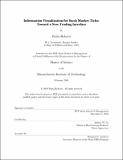| dc.contributor.advisor | Andrew W. Lo. | en_US |
| dc.contributor.author | Roberts, Pasha, 1962- | en_US |
| dc.contributor.other | Sloan School of Management. | en_US |
| dc.date.accessioned | 2005-05-17T14:51:53Z | |
| dc.date.available | 2005-05-17T14:51:53Z | |
| dc.date.copyright | 2003 | en_US |
| dc.date.issued | 2004 | en_US |
| dc.identifier.uri | http://hdl.handle.net/1721.1/16668 | |
| dc.description | Thesis (S.M.)--Massachusetts Institute of Technology, Sloan School of Management, February 2004. | en_US |
| dc.description | Includes bibliographical references (leaves 80-82). | en_US |
| dc.description | This electronic version was submitted by the student author. The certified thesis is available in the Institute Archives and Special Collections. | en_US |
| dc.description.abstract | Ticks, the second-to-second trades and quotes of a market, might be considered the atoms of finance. They represent the basic, defining transactions that represent an asset in the market. Almost all financial concepts, such as returns or risk, are essentially abstractions from tick data. Like atoms, ticks form a truly massive dataset - millions per day, far too numerous to represent with traditional graphical methods. Information-intensive disciplines such as medicine, bioinformatics, the earth sciences, and computational fluid dynamics have adopted modern visualization methods to manage and explore their respective mountains of data. Finance, however, has done little with the discipline of visualization to date. This research presents the hypothesis that information visualization of tick data can improve human performance for intraday equity trading. To consider the hypothesis, the act of equity trading is broken into functional tasks, and the tasks mapped to information requirements. Using the TAQ historical dataset, the research evaluates new 2D and 3D information designs for tick data, and creates a visual language for equity trading. The functional tasks and information designs are implemented in a visualization application, which provides an almost purely graphical trading interface to historical ticks. The user experience, trading performance, and analytical insight from this application are evaluated versus numeric methods. Based upon this experiment, the research concludes by exploring the usability, potential issues and future directions of trading and tick visualization in general. | en_US |
| dc.description.statementofresponsibility | by Pasha Roberts. | en_US |
| dc.format.extent | 83 leaves | en_US |
| dc.format.extent | 3623265 bytes | |
| dc.format.extent | 3645479 bytes | |
| dc.format.mimetype | application/pdf | |
| dc.format.mimetype | application/pdf | |
| dc.language.iso | eng | en_US |
| dc.publisher | Massachusetts Institute of Technology | en_US |
| dc.rights | M.I.T. theses are protected by copyright. They may be viewed from this source for any purpose, but reproduction or distribution in any format is prohibited without written permission. See provided URL for inquiries about permission. | en_US |
| dc.rights.uri | http://dspace.mit.edu/handle/1721.1/7582 | |
| dc.subject | Sloan School of Management. | en_US |
| dc.title | Information visualization of the stock market ticks : toward a new trading interface | en_US |
| dc.type | Thesis | en_US |
| dc.description.degree | S.M. | en_US |
| dc.contributor.department | Sloan School of Management | |
| dc.identifier.oclc | 56675083 | en_US |
